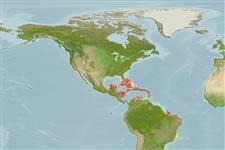>
Ophidiiformes (Cusk eels) >
Dinematichthyidae (Viviparous brotula)
Etymology: Ogilbichthys: Named for the great Australian ichthyologist, J. Douglas Ogilby.; longimanus: Named for the long pectoral fins which are longer than in any other American dinematichthyine..
More on authors: Møller, Schwarzhans & Nielsen.
Environment: milieu / climate zone / depth range / distribution range
Ecologia
marinhas associadas(os) a recifes; intervalo de profundidade 0 - 15 m (Ref. 55786). Tropical
Western Central Atlantic: off Cayman Islands, Bahamas and Haiti.
Tamanho / Peso / Idade
Maturity: Lm ? range ? - ? cm
Max length : 7.3 cm SL (female)
Descrição suscinta
Chaves de identificação | Morfologia | Morfometria
Raios dorsais (total) : 70 - 79; Raios anais : 55 - 64; Vértebras: 40 - 43. This species is characterized by the following: pectoral fins long (16.7-20.3% SL); soft interorbital broad (7-9.4%SL); pectoral distance long (33.2-37.4%SL); elongate neural spines 4; rows of large scales on lower cheeks 3; outer pseudoclasper a broad, rounded lobe; fleshy isthmus between pseudoclaspers wide; anterior inner pseudoclasper submerged in pocket of isthmus; otolith with fused colliculi (Ref. 55786).
Ciclo de vida ou comportamento de acasalamento
Maturities | Reprodução | Spawnings | Egg(s) | Fecundities | Larvas
Møller, P.R., W. Schwarzhans and J.G. Nielsen, 2004. Review of the American Dinematichthyini (Teleostei, Bythitidae). Part I. Dinematichthys, Gunterichthys, Typhliasina and two new genera. aqua, J. Ichthyol. Aquat. Biol. 8(4):141-192. (Ref. 55786)
Status na Lista Vermelha da UICN (Ref. 130435)
Ameaça para os humanos
Harmless
Uso pelos humanos
Ferramentas
Relatórios especiais
Baixar XML
Fontes da internet
Estimates based on models
Preferred temperature (Ref.
123201): 26.5 - 28.1, mean 27.5 °C (based on 409 cells).
Índice de diversidade filogenética (Ref.
82804): PD
50 = 0.5078 [Uniqueness, from 0.5 = low to 2.0 = high].
Bayesian length-weight: a=0.01000 (0.00244 - 0.04107), b=3.04 (2.81 - 3.27), in cm total length, based on all LWR estimates for this body shape (Ref.
93245).
Nível Trófico (Ref.
69278): 3.3 ±0.5 se; based on size and trophs of closest relatives
Fishing Vulnerability (Ref.
59153): Low vulnerability (10 of 100).
